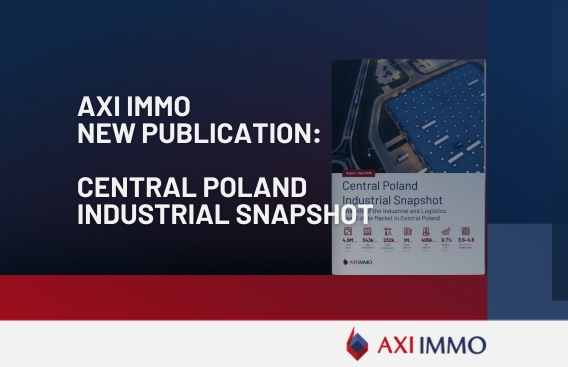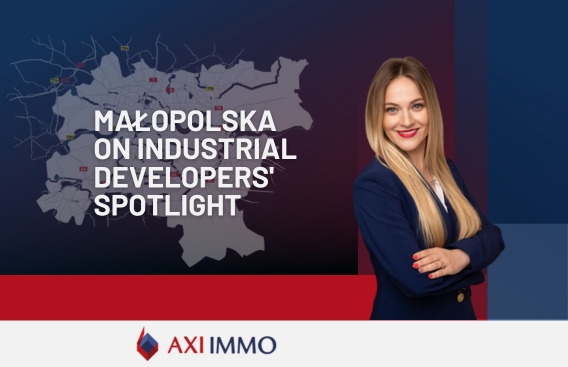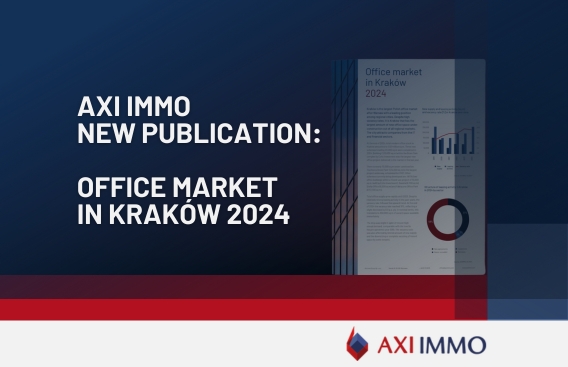Polish Industrial Market in H1 2024 – report by AXI IMMO
Poland's industrial market is picking up again. Rebound in take-up with a high share of renewals.
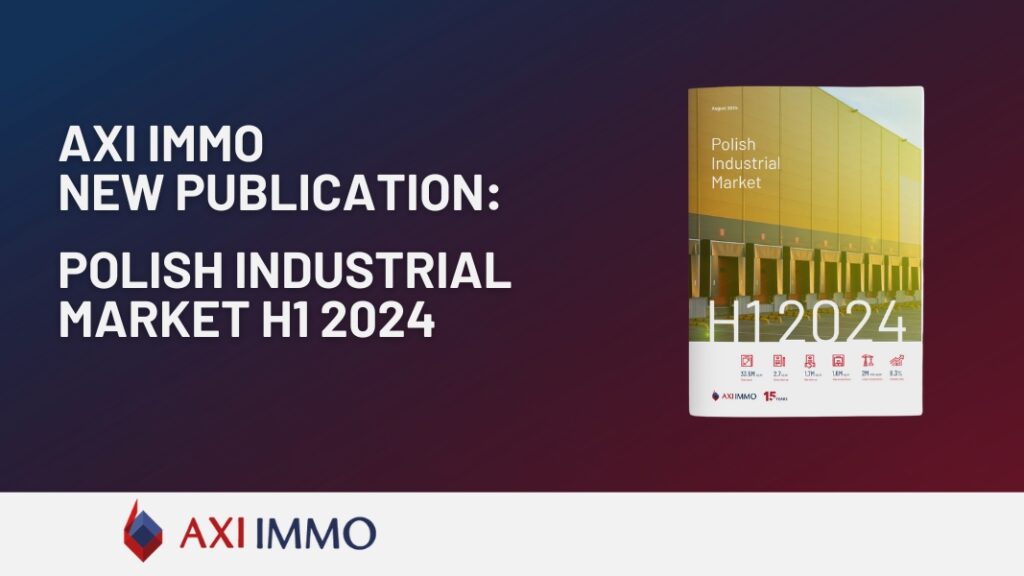
AXI IMMO, the largest Polish commercial real estate firm, has released its latest analysis, ‘Polish Industrial Market H1 2024’.
The overall volume of lease transactions in the Polish industrial sector in H1 2024 was 2.7 million sq m. The result was primarily based on extensions, which accounted for around 40% of the contracts signed. The high take-up rate is a positive indicator of the market’s performance. With take-up high, supply is maintained by gradually applying the brakes. Between January and the end of June 2024, developers maintained the market’s year-to-date growth rate of over 10% year on year (33.5 million sq m), delivering around 1.6 million sq m of new industrial and logistics space. Moderate new supply and a resurgence in take-up resulted in vacancy and headline rental rate stability.
Investment: The market is coming to life
At the end of June 2024, the industrial market in Poland accounted for EUR 294 million (17% of the total), a 33% decrease compared to H1 2023. Of the 11 transactions concluded in H1 2024, the largest was the acquisition of Panattoni Park Poznań XI by EQT Exeter (129,400 sq m) in Q2 2024, while the second was the purchase of two neighbouring parks, West Park Pruszków and West Park Ożarów (totalling 81,900 sq m) by Hillwood from DWS/RREEF in Q1 2024.
Grzegorz Chmielak, Head of Valuation and Capital Markets, AXI IMMO, comments: “Industrial and logistical assets continue to be of interest to investors, particularly in the context of big box multi-tenant ventures. We see a situation in which developers are significantly more likely to opt to acquire existing buildings due to high construction costs and difficulty financing new projects. Despite lower investment activity than prior years, the market is gradually rebounding. Reducing inflationary pressures and the ECB’s interest rate drop may reinvigorate transactions and encourage new players to enter the Polish market. On the other hand, investors are cautious, selecting projects carefully and ready for greater acquisitions next year.”
Take-up: Rebound with a high share of renewals
In the first six months of 2024, the total lease volume on the Polish Industrial market amounted to 2.7 million sq m (+23% y-o-y), with a 39% share of lease renewals. The result for renegotiations increased by 26% year-on-year. On the other hand, 1.7 million sq m (+22% y-o-y) was signed in purely new contracts (net take-up). The three most active provinces were Dolnośląskie (nearly 527,000 sq m), Mazowieckie (506,000 sq m), the podium is closed by Śląskie (469,000 sq m). The so-called ‘big five’ continue to dominate the Polish industrial market. In the first half of 2024, it collectively accounted for 81% of gross take-up on the Polish market. Among the largest lease transactions between January and June 2024 was a new contract signed by a retail company in Bydgoszcz Białe Błota LC in Kujawsko-Pomorskie Voivodeship for 103,800 sq m, while in Dolnośląskie, a 3PL decided to extend and expand an existing contract in Prime Logistics Wrocław Pietrzykowice (98,700 sq m). The third place was a new contract, under which an e-commerce tenant will move into Panattoni Wrocław Logistics South Hub for 91,000 sq m.
Anna Głowacz, Head of Industrial, AXI IMMO, points out: “New warehouse projects are presently more expensive than existing facilities due to rising investment expenditures, particularly building, compared to prior years. Furthermore, in the face of personnel shortages, renters prefer to remain in their current sites to maintain their existing workforce. Nonetheless, we are witnessing a good trend in the form of an increase in rented space due to both new leases and the growth of current companies.”
Supply: Normalisation in developer’s activity
At the end of June 2024, 1.6 million sq m (-37% y-o-y) of new supply brought the total stock of modern industrial space to 33.5 million sq m (+10% y-o-y). The highest developer activity in H1 2024 was recorded in Dolnośląskie (423,000 sq m), Pomorskie (239,000 sq m) and Mazowieckie (235,000 sq m) provinces. The largest warehouse parks delivered included CTPark Gdańsk Port (119,400 sq m), Panattoni Park Wrocław Logistics South Hub (90,000 sq m) and GLP Wrocław V Logistics Centre (86,200 sq m). At the end of June 2024, there was almost 2 million sq m (-6.2% y-o-y) under construction, with the largest amount in Dolnośląskie (568,000 sq m), Mazowieckie (410,000 sq m) and Łódzkie (322,000 sq m) Voivodeships. Around 45% of the new supply currently under construction is speculative. Moderate development activity and higher take-up in H1 2024 stabilised the vacancy rate at 8.3% (+160 bps y-o-y). The highest vacancy rate is in the Lubuskie Voivodeship (19.3%), ahead of the Świętokrzyskie Voivodeship (16.1%) and the Łódzkie Voivodeship (10.8%).
Rents: Declines in effective rates in selected regions
At the end of June 2024, average headline rents remained stable in most locations. Landlord expectations in big-box developments fluctuate between EUR 3.6 and EUR 5.5 / sq m / month. The most attractive base rents, below EUR 4.0 / sq m / month, are obtainable in selected projects in Piotrków Trybunalski, Stryków, the vicinity of Poznań and Warsaw. The highest headline rental rates apply to projects in Warsaw and Kraków, above EUR 5.0 – 6.0 / sq m / month. A slight downward trend in effective rates of 15% to 25% is visible in selected highly competitive markets. In contrast, owners’ expectations are, on average, 10-15% higher in projects under construction and planned developments than the offer available in older facilities.
Renata Osiecka, Managing Partner, AXI IMMO, concludes: “Despite a slower consumer recovery and a reduction in output, Poland’s industrial market will grow gradually in the second half of 2024. Extending leases in current locations will continue, although client development will be selective. We expect the end of 2024 to offer even greater optimism on the take-up front. On the supply side, we anticipate that developers would choose projects with pre-leases over speculative space. On the other hand, ongoing due diligence processes point to increased transactions in the investment sector in the coming quarters.”
Report — Report "Polish Industrial Market H1 2024"
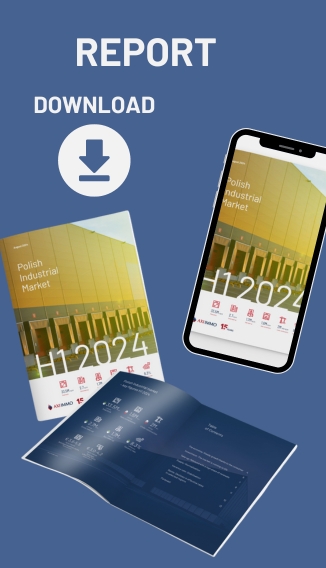
Recent articles
14 April 2025
New Work expands in Warsaw with new serviced offices space at Metron building, AXI IMMO advises
Serviced offices at New Work in Warsaw, just steps away from Metro Wierzbno station.
9 April 2025
Central Poland Industrial Snapshot – Analysis of the industrial and logistics real estate market in Central Poland, AXI IMMO publication
High industrial take-up in Łódź region in 2024 driven by lease renewals
3 April 2025
AXI IMMO presents its analysis of the industrial & logistics market in Małopolska, southern Poland
Małopolska on developers' spotlight: more space for industrial and logistics on the horizon.
24 March 2025
Office market in Kraków 2024, Poland, publication by AXI IMMO, 2025 March – Analysis, trends, forecasts
Kraków is the leader of regional office markets – tenant activity is growing. AXI IMMO's special publication on Office market in Krakow in 2024, Poland includes an analysis of supply, demand, rental rates, as well as trends and forecasts on the Krakow office market in 2025 and 2026.

